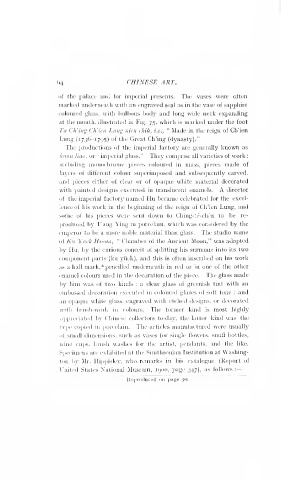Page 232 - Chinese Art, Vol II By Stephen W. Bushell
P. 232
64 CHINESE ART. — :
of the palace and for imperial presents. The vases were often
marked underneath with an engraved seal as in the vase of sapphire
coloured glass, with bulbous body and long wide neck expanding
at the mouth, illustrated in Fig. 75, which is marked under the foot
"
Ta Ch'ing Ch'icn Lung nien chih, i.e., Made in the reign of Ch'ien
Lung (1736-1795) of the Great Ch'ing (dynasty)."
The productions of the imperial factory are generally known as
kuan liao, or " imperial glass." They comprise all varieties of work
including monochrome pieces coloured in mass, pieces made of
layers of different colour superimposed and subsequently carved,
and pieces either of clear or of opaque white material decorated
with painted designs executed in translucent enamels. A director
of the imperial factory named Hu became celebrated for the excel-
lence of his work in the beginning of the reign of Ch'ien Lung, and
some of his pieces were sent down to Ching-te-chen to be re-
produced by T'ang Ying in porcelain, which was considered by the
emperor to be a more noble material than glass. The studio name
of Ku Yiieh Hsiian, " Chamber of the Ancient Moon," was adopted
by Hu, by the curious conceit of splitting his surname into its two
component parts (ku yiieh), and this is often inscribed on his work
as a hall mark,* pencilled underneath in red or in one of the other
enamel colours used in the decoration of the piece. The glass made
by him was of two kinds : a clear glass of greenish tint with an
embossed decoration e.xecuted in coloured glazes of soft tone : and
an opaque white glass, engraved with etched designs, or decorated
with brush-work in colours. The former kind is most highly
appreciated by Chinese collectors to-day, the latter kind was the
type copied in porcelain. The articles manufactured were usually
of small dimensions, such as vases for single flowers, snuff bottles,
wine cups, brush washes for the artist, pendants, and the like.
Specimens are exhibited at the Smithsonian Institution at Washing-
ton by Mr. Hippisley, who remarks in his catalogue (Report of
United States National Museum, 1900, page 347), as follows :
* Reproduced on page 50.

